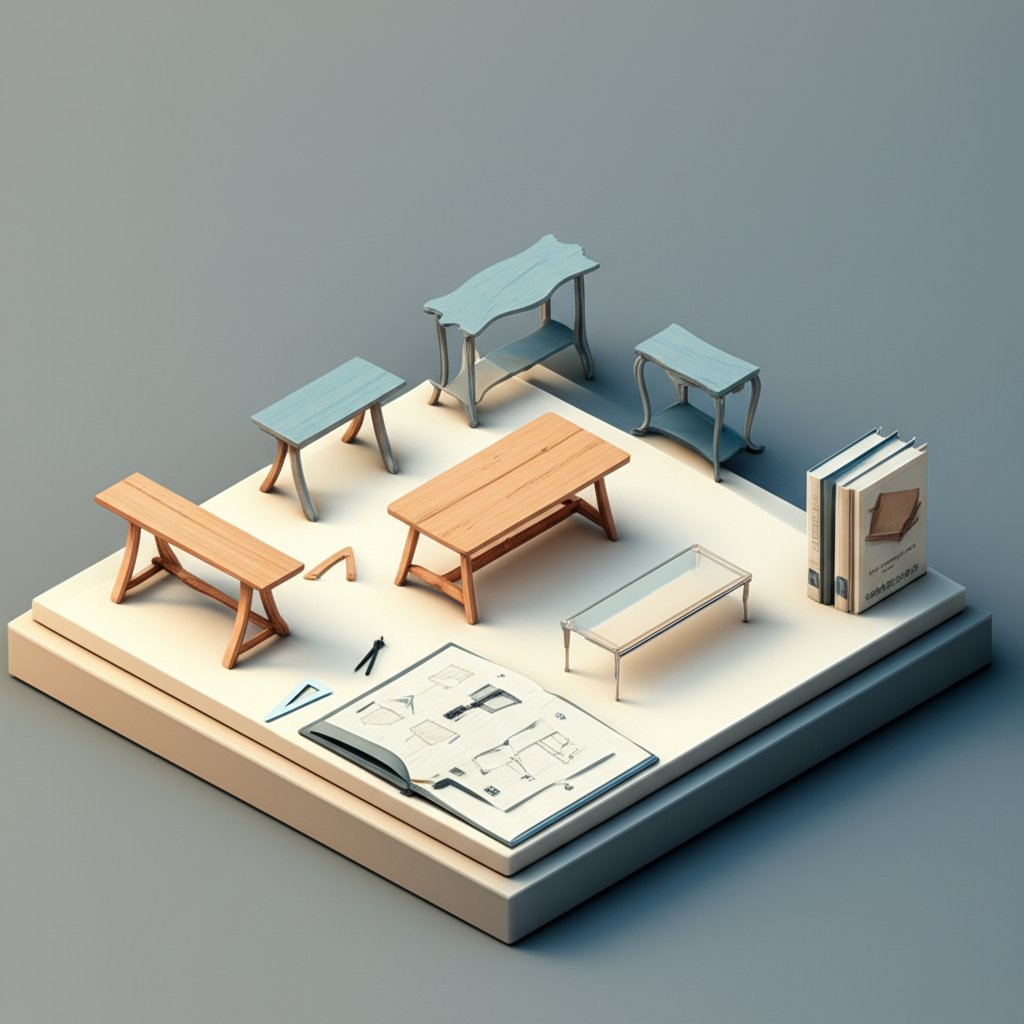Welcome to the definitive exploration of table furniture, a cornerstone of human civilization and interior design. Often taken for granted, tables are far more than mere flat surfaces; they are silent witnesses to history, masterpieces of design, and indispensable elements of daily life. From ancient banquets to modern workspaces, tables have facilitated our work, nourished our bodies, and brought us together. This comprehensive guide will delve deep into the rich history of tables, unpack the intricacies of table design, categorize the vast types of tables available today, and unveil a treasure trove of fascinating facts about tables that will undoubtedly enhance your appreciation for these essential pieces. Prepare to transform your understanding of table furniture, moving beyond its simple utility to grasp its profound cultural and aesthetic significance.
The Enduring History of Tables: From Ancient Innovation to Modern Icon

The history of tables is a fascinating journey through human ingenuity, reflecting evolving social customs, technological advancements, and artistic expressions across millennia. From rudimentary platforms to elaborate dining sets, tables have consistently adapted to human needs.
Early Beginnings: Practicality in Ancient Civilizations
The earliest forms of table furniture emerged out of necessity.
- Ancient Egypt (Circa 2200 B.C.): Egyptians were among the first civilizations to utilize tables. Initially, these were simple, low structures, often made from carved stone or wood, primarily used to keep objects off the ground. They also played a crucial role in ritualistic practices and even as embalming tables during mummification. Intriguingly, Egyptians also incorporated tables into their leisure, serving as surfaces for games and social gatherings, highlighting their early multi-functional role.
- Mesopotamia & China: In these ancient cultures, tables often served practical purposes for artisans and scholars. Elevated surfaces were essential for crafting tools, carving intricate artworks, or providing a stable platform for writing and painting. Chinese artistry, in particular, saw wooden tables evolve into works of art, adorned with exquisite carvings that reflected rich cultural narratives.
Classical Innovations: The Rise of Dining and Social Tables
The Greeks and Romans revolutionized the social role and table design.
- Ancient Greece: The Greeks pioneered the concept of dedicated dining tables. Before their time, people typically ate while sitting or reclining on the floor. The Greeks introduced elevated tables, often lightweight and movable, accompanied by chairs or couches. These early “gueridon”-style tables, featuring single-column supports with small circular surfaces, could be pulled close during meals and then stowed away. This innovation transformed the dining experience, making it more comfortable and communal.
- Ancient Rome: Building on Greek forms, Romans embraced more elaborate tables. Their dining spaces, known as tricliniums, featured U-shaped arrangements of couches around a central table. These tables, often crafted from luxurious materials like marble, metal, and fine woods, were central to lavish feasts. The Latin word mensa, meaning table, became synonymous with “meal,” underscoring its cultural significance. Roman tables showcased burgeoning artistry with intricate embellishments and opulent designs.
The Medieval Shift: Functionality and Feasting Halls
The Middle Ages brought a return to more utilitarian table furniture.
- Early Medieval Europe: Amidst political turmoil, luxury gave way to practical necessity. Trestle tables became prevalent – simple, sturdy planks resting on detachable supports. Their portable nature allowed them to be easily dismantled and moved, fitting the transient lifestyle of the era.
- Nobility and Great Halls: In grand castles and manor houses, massive trestle tables dominated great halls. These served as central gathering points for communal meals, where seating arrangements strictly reflected social hierarchies, with lords and ladies seated at the high table (dais) and others arrayed below.
Renaissance to Modernity: Craftsmanship, Specialization, and Industrialization
Subsequent eras brought further sophistication and diversity to table design.
- Renaissance (14th-17th Century): As Europe emerged from the Middle Ages, there was a renewed interest in classical forms and artistic expression. Tables became more refined with elaborate carvings, inlays, and turning techniques. Dining rooms began to emerge as distinct spaces, necessitating more permanent and decorative dining tables.
- 18th & 19th Centuries: The Industrial Revolution introduced new manufacturing techniques, making tables more accessible. Styles diversified dramatically with movements like Rococo, Neoclassical, and Victorian, each leaving its distinct mark on table design. Desks, in particular, gained significant popularity in the late 17th century, providing dedicated workspaces for reading, writing, and organizing documents, becoming symbols of productivity. Innovators like Charles Darwin even designed a standing table, showcasing early ergonomic thinking in furniture.
- 20th Century & Beyond: Modernism, Art Deco, Mid-Century Modern, and contemporary movements continued to push the boundaries of table design. New materials like steel, glass, and plastics became common, allowing for sleek, minimalist, and often sculptural forms. Today, tables blend aesthetics with smart functionality, integrating technology and adapting to evolving lifestyles.
Exploring Diverse Types of Table Furniture for Every Space and Need
The sheer variety of table furniture available today is staggering, each type meticulously designed to fulfill specific functions and enhance particular spaces. Understanding these types of tables is key to making informed choices for your home or office.
As you delve into the nuances of table construction, it’s worth exploring how these methods tie into the larger world of furniture creation, and learning some interesting facts about furniture making can deepen your appreciation for the craft.
Dining & Kitchen Tables
These are central to gathering and meals.
- Dining Table: The quintessential table for shared meals, ranging from intimate two-seaters to grand banquet tables. They come in various shapes (rectangular, round, oval, square) and styles to match any dining room aesthetic.
- Kitchen Table (or Breakfast Nook Table): Often smaller and more casual than a dining table, designed for everyday meals and quick gatherings in the kitchen.
- Bar Table/Counter-Height Table: Taller tables paired with stools, offering a casual dining or entertaining space, often mimicking a bar setting.
- Extendable/Drop-Leaf Table: Versatile tables that can be expanded to accommodate more guests or folded down to save space, ideal for smaller living areas.
Living Room Tables
These tables enhance comfort and functionality in social spaces.
- Coffee Table: A low table placed in front of a sofa, primarily for holding drinks, books, or decorative items. Many designs include storage.
- End Table/Side Table: Small tables placed at the end of a sofa or beside an armchair, perfect for lamps, remote controls, or drinks.
- Console Table/Sofa Table: Long, narrow tables, often placed against a wall, behind a sofa, or in an entryway, used for display, lamps, or keys.
- Nesting Tables: Sets of two or more tables of varying sizes that fit together, offering flexible surfaces when needed and compact storage when not.
Workspace & Study Tables
Designed for productivity and organization.
- Desk: A table explicitly designed for working, writing, or studying. Desks come in many forms, including executive desks, writing desks, computer desks, and standing desks.
- Conference Table: Large tables found in offices, designed to accommodate multiple people for meetings and collaborations.
- Work Table/Workbench: Robust, durable tables used for specific tasks, crafts, or workshops, often featuring ample surface area and storage for tools.
Bedroom & Personal Tables
Tailored for personal use and comfort.
- Bedside Table/Nightstand: Small tables placed next to a bed, for lamps, alarm clocks, books, and personal items. Often includes drawers or shelves.
- Dressing Table/Vanity Table: A table with a mirror, often accompanied by drawers, used for personal grooming and applying makeup.
- Changing Table: A specialized table with safety rails, designed for changing baby diapers.
Specialty & Decorative Tables
Tables with unique functions or aesthetic focuses.
- Billiard/Pool Table: A large, specialized table for playing billiards or pool.
- Game Table (e.g., Chess Table, Poker Table): Tables designed specifically for playing particular games, often with built-in features or specific dimensions.
- Credence Table: A small side table, often found in churches, used to hold sacred vessels.
- Accent Table: A general term for smaller, often decorative tables used to fill a space, provide a surface for an object, or add a touch of style.
- Folding Table: Portable tables that can be easily folded and stored, ideal for temporary use or outdoor events.
- Pedestal Table: A table supported by a central column instead of multiple legs, offering a more open base.
The Art and Science of Table Design: Aesthetics, Functionality, and Evolution
Table design is a dynamic intersection of form, function, and artistic expression. It considers not only how a table looks but also how it serves its purpose, interacts with its environment, and withstands the test of time.
Key Elements of Table Design
Every table is composed of fundamental elements that contribute to its overall design.
- Tabletop: The primary working or display surface. Its shape (rectangular, round, oval, square, irregular), size, and thickness dictate much of the table’s utility and aesthetic.
- Base/Legs: These provide stability and support. The variety here is dazzling – from traditional four-legged designs to single pedestals, trestle bases, U-shaped frames, geometric sculptures, or even unconventional leg arrangements. The style of the legs can dramatically influence the table’s character and stability.
- Materials: The choice of material is paramount to table design, impacting durability, weight, maintenance, and visual appeal.
- Wood: Timeless and versatile, offering warmth, natural beauty, and durability. Common woods include oak, maple, walnut, cherry, and teak. Different finishes (stained, painted, reclaimed) offer varied aesthetics.
- Metal: Modern and industrial, offering strength and sleekness. Steel (stainless, brushed), iron, and aluminum are common. Can be polished, painted, or left raw.
- Glass: Creates an illusion of space and lightness, offering a contemporary and sophisticated look. Often paired with metal or wood bases.
- Stone: Marble, granite, and concrete offer luxurious, robust, and permanent surfaces with unique veining and textures.
- Plastics/Composites: Lightweight, versatile, and often used for contemporary or outdoor designs. Easily molded into various shapes and colors.
- Mixed Materials: Many modern tables combine materials, such as a wooden top with metal legs, or a glass top on a stone base, to achieve distinctive looks and functional benefits.
Influential Design Styles and Movements
Table design has constantly evolved with broader artistic and architectural movements.
- Classical (Greek & Roman Influence): Emphasized balance, symmetry, and often decorative carvings, using rich materials.
- Gothic (Medieval): Focused on robust, sturdy construction, often with heavy wooden tops and substantial trestle bases.
- Renaissance: Reintroduced classical motifs, featuring ornate carvings, turned legs, and often highly decorative inlays.
- Baroque & Rococo: Characterized by elaborate ornamentation, curvilinear forms, and luxurious finishes, often reflecting grandeur and extravagance.
- Neoclassical: A return to the simplicity and elegance of classical antiquity, with cleaner lines and restrained decoration.
- Victorian: Eclectic and often heavy, combining various historical styles with elaborate carvings, dark woods, and ornate details.
- Arts and Crafts: Emphasized craftsmanship, honest materials, and simple, functional designs, rejecting industrial mass production.
- Art Deco: Geometric patterns, sleek lines, exotic materials, and a sense of luxury and modernity define this influential style.
- Mid-Century Modern: Emerged in the post-WWII era, characterized by clean lines, organic shapes, functionality, and innovative use of materials like plywood, plastic, and metal.
- Minimalist & Contemporary: Focus on simplicity, clean lines, uncluttered aesthetics, and often innovative materials, prioritizing function and subtle elegance.
Functionality and Ergonomics in Design
Beyond aesthetics, effective table design considers user experience.
- Ergonomics: Especially crucial for desks and work tables, ergonomics involves designing tables that support correct posture and reduce strain. This includes adjustable height desks, proper keyboard trays, and adequate legroom.
- Versatility: Many tables are designed for adaptability. Examples include nesting tables for flexible surface area, extendable dining tables for varying guest numbers, or lift-top coffee tables that convert into workspaces.
- Storage: Integrated drawers, shelves, or cabinets within tables enhance their functionality, helping to keep spaces organized and clutter-free.
- Durability and Maintenance: The chosen materials and construction methods directly impact a table’s longevity and ease of care, important considerations for any user.
Fascinating Facts About Tables You Never Knew
Beyond their functional utility, tables hold a wealth of intriguing stories and unique characteristics. Here are some fascinating facts about tables that highlight their diverse roles and surprising history.
- Tables Predate Chairs: While the Greeks were instrumental in pairing tables with chairs for dining, tables themselves existed long before chairs became common. Early civilizations often used tables while sitting or reclining on the ground.
- The Oldest Known Book Storage wasn’t a Bookshelf: While not a “table” in the modern sense, the oldest known bookcase, found in the Bodleian Library at Oxford University, is a testament to how furniture, including table-like structures, has preserved knowledge for centuries.
- Feng Shui and Table Shapes: In the practice of Feng Shui, the shape of your table is believed to significantly influence energy flow (chi) in a space. Round tables are often favored for promoting harmony and connection, while sharp-edged rectangular tables can create more rigid energy patterns.
- Charles Darwin, Furniture Innovator: The renowned naturalist Charles Darwin was not just a scientist; he was also an inventor. Among his ingenious creations was a standing desk, allowing him to work upright, showcasing an early application of ergonomic principles in table design.
- The World’s Largest Dining Table: Imagine a meal with 1,000 people! The largest dining table ever assembled was a record-breaking feat, emphasizing the enduring human desire for communal dining experiences.
- The Average Person Spends a Third of Their Life at a Table: Studies suggest that across various activities—dining, working, studying, socializing—an average person spends a significant portion of their life interacting with tables. They truly are constant companions.
- The Etymology of “Table”: The word “table” itself has ancient roots, derived from Old English and Latin words like “tabula,” meaning “a board” or “flat surface.” This simple origin underscores the fundamental nature of tables.
- Work Tables for Seamstresses: In previous centuries, specialized, small work tables, often with convenient compartments and storage areas, were a haven for seamstresses, providing an organized and dedicated space for their creative endeavors. This exemplifies tables being tailored to specific occupations.
- Tables as Symbols: Beyond function, tables carry symbolic weight. A dining table often symbolizes family gatherings, unity, and bonding, while a conference table represents collaboration and decision-making.
- The Roman “Mensa Secunda”: In ancient Rome, the Latin term mensa meant table, but mensa secunda (literally “second meal”) actually referred to dessert, demonstrating how deeply integrated tables were with the concept of dining.
Choosing the Perfect Table: A Guide to Materials, Shapes & Styles
Selecting the ideal table furniture requires careful consideration of its intended use, the space it will occupy, and your personal aesthetic. This section offers actionable guidance to help you make the best choice.
Assess Your Needs and Space
Before diving into styles, consider these practical aspects:
- Purpose: What will the table primarily be used for? Dining, working, display, storage, or a combination?
- Location: Where will the table be placed? Kitchen, dining room, living room, office, bedroom, outdoors?
- Size and Dimensions: Measure your space accurately. Ensure there’s enough room for the table itself, comfortable seating around it (if applicable), and clear pathways. For dining tables, allow at least 24 inches for each seated person and 36-48 inches clearance around the table for moving chairs.
- Traffic Flow: How will the table affect movement through the room? Round or oval shapes can be better for smaller, high-traffic areas as they eliminate sharp corners.
- Existing Decor: Consider the current style, color palette, and materials of your surrounding furniture to ensure the new table complements the room.
Selecting the Right Material
The choice of material impacts durability, maintenance, and aesthetic appeal.
- For Durability and Warmth: Hardwoods like oak, walnut, or mahogany are classic choices, offering longevity and a rich, natural look. Reclaimed wood adds character and sustainability.
- For Modernity and Lightness: Glass or acrylic tops create an airy feel and can make small spaces appear larger. They are easy to clean but can show fingerprints.
- For Industrial or Sleek Aesthetics: Metal (steel, iron) offers strength and a contemporary edge. It can be paired with wood or glass for varied designs.
- For Luxury and Robustness: Marble, granite, or concrete provide a heavy, high-end feel, though they can be susceptible to staining or chipping depending on the stone.
- For Outdoor Use: Teak, aluminum, resin wicker, or treated metals are designed to withstand the elements.
Choosing the Ideal Shape
The shape of your tabletop influences functionality and room dynamics.
- Rectangular Tables: Most common, ideal for larger groups and formal settings. Fits well in elongated rooms.
- Round Tables: Foster intimacy and conversation as everyone faces each other. No sharp corners, making them good for small spaces or homes with children.
- Oval Tables: Offer the benefits of both rectangular (more surface area) and round (no sharp corners). Can seat more people than a round table of similar width.
- Square Tables: Best for smaller, square rooms or intimate dining. Can be pushed together to form a larger rectangular table.
- Irregular/Organic Shapes: Offer a unique, artistic statement, often found in contemporary or custom-designed tables.
Embracing Design Styles
Match your table to your personal taste and home’s architectural style.
- Traditional: Look for classic wood finishes, turned legs, carved details, and timeless shapes (e.g., Queen Anne, Chippendale).
- Modern/Contemporary: Prioritize clean lines, geometric shapes, minimalist aesthetics, and materials like glass, metal, and light-colored woods.
- Farmhouse/Rustic: Embrace distressed wood, sturdy construction, trestle bases, and a warm, inviting feel.
- Industrial: Combine raw materials like reclaimed wood, exposed metal pipes, and robust construction.
- Mid-Century Modern: Seek out organic shapes, tapered legs, and a blend of natural woods with subtle pops of color.
By thoughtfully considering these factors, you can select table furniture that not only meets your practical needs but also enhances the beauty and functionality of your living spaces for years to come.
Conclusion

From the rudimentary stone slabs of ancient Egypt to the sleek, smart designs of today, table furniture has always been at the heart of human activity. We’ve journeyed through the rich history of tables, witnessing their evolution from simple utilitarian objects to sophisticated pieces of art and engineering. We’ve explored the diverse types of tables, each serving a unique purpose, and delved into the intricate considerations of table design, from material selection to ergonomic principles. Finally, we’ve unveiled a collection of fascinating facts about tables that underscore their enduring cultural and social significance.
Tables are far more than just surfaces; they are essential companions in our daily lives, facilitating connection, creativity, and sustenance. They are the stage upon which countless memories are made, stories are shared, and work is accomplished. By understanding the depth and breadth of their existence, we gain a profound appreciation for these remarkable creations. As you interact with tables in your own life, remember the millennia of innovation and design that stand beneath your fingertips.
FAQ Section
Q1: What are the main historical periods that influenced table design?
A1: Key historical periods influencing table design include Ancient Egypt (early practical use), Ancient Greece and Rome (pioneering dining tables and elaborate designs), the Medieval era (functional trestle tables), the Renaissance (ornate craftsmanship), and modern movements like Art Deco and Mid-Century Modern (embracing new materials and sleek aesthetics).
Q2: How does table shape affect a room’s functionality and aesthetics?
A2: Table shape significantly impacts a room. Rectangular tables are efficient for seating many and suit elongated rooms, while round tables foster intimacy and are ideal for smaller spaces or high-traffic areas due to their lack of sharp corners. Oval tables offer a balance, providing ample surface without harsh edges, and square tables are great for intimate settings or combining.
Q3: What are some common materials used in table construction and their characteristics?
A3: Common table materials include wood (warm, durable, versatile), metal (sleek, strong, industrial), glass (light, modern, creates illusion of space), stone like marble or granite (luxurious, robust, unique patterns), and plastics/composites (lightweight, versatile, contemporary). Many modern tables combine these materials for aesthetic and functional benefits.
Q4: Besides dining, what are some other primary uses and types of table furniture?
A4: Beyond dining, tables serve numerous purposes:
Each type is specifically designed to maximize its intended function.
Q5: What makes a table design “ergonomic”?
A5: An ergonomic table design prioritizes user comfort, health, and productivity. For example, ergonomic desks may be height-adjustable (standing desks) to promote better posture, provide ample legroom, or have features that reduce strain during prolonged use, such as built-in cable management or monitor mounts.
Q6: Can tables influence productivity or mood in a workspace?
A6: Yes, psychological research and practices like Feng Shui suggest that table design and placement can influence productivity and mood. A well-designed, organized workspace table can reduce clutter and distraction, fostering focus. In Feng Shui, table shape and positioning are believed to affect energy flow, impacting well-being and collaboration.










